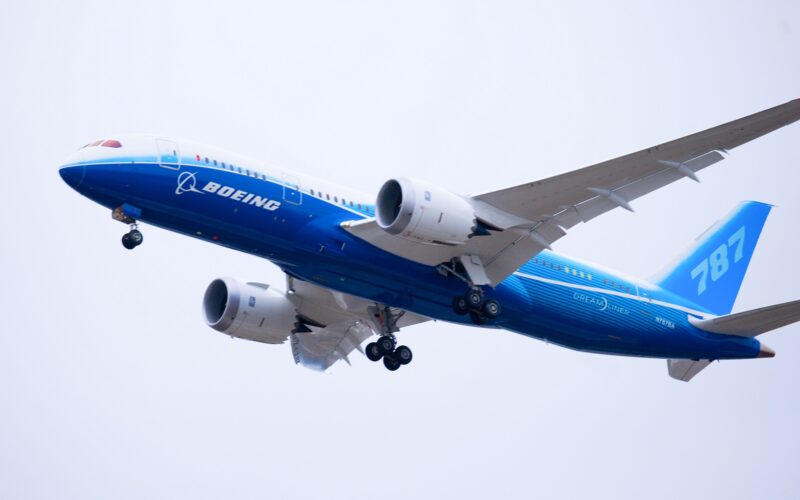In a final rule Airworthiness Directive (AD), the United States (US) Federal Aviation Administration (FAA) is addressing water leaking on multiple pieces of electronic equipment, including critical flight equipment, on the Boeing 787-8, 787-9, and 787-10.
The AD was finalized following a notice of proposed rulemaking (NPRM) on May 25, 2023. The FAA published the NPRM on December 13, 2022, inviting parties to comment on the proposed directive.
Initially, the FAA was prompted to issue the NPRM following “reports of a loss of water pressure during flight and water leaks that affected multiple pieces of electronic equipment”. The proposed rulemaking document detailed that all Boeing 787 aircraft operators were required to conduct a detailed visual inspection (DVI) of all door 1 and door 3 lavatory and galley potable water systems for any missing or incorrectly installed clamshell couplings. If required, airlines would have to apply corrective actions to address the unsafe condition.
“The FAA is issuing this AD to address incorrectly installed or missing lavatory and galley clamshell couplings that could lead to water leaks and water migration to critical flight equipment, which may affect the continued safe flight and landing of the airplane,” read the final rule AD.
The agency estimated that 134 Boeing 787 aircraft registered in the US are subject to the directive, which is effective June 29, 2023. In order to comply with the AD, airlines must conduct a DVI of the lavatory and galley, which the FAA estimated would cost $85 in labor.
“The FAA has received no definitive data on which to base the cost estimates for the on-condition actions specified in this AD,” the regulator noted.
Insufficiently addressed unsafe condition
Five commenters have addressed the directive, including Air Line Pilots Association, International (ALPA), which supported the AD without change.
American Airlines, Boeing, and Japan’s All Nippon Airways (ANA) requested that the FAA would only include aircraft listed in Boeing Alert Requirements Bulletin B787–81205–SB380021–00 RB, Issue 001, dated August 12, 2022, as the affected units, without including undelivered aircraft.
The three commentators argued that Boeing has already “taken several steps to prevent missing or misinstalled lavatory and galley clamshell couplings on airplanes” not listed in the bulletin. Furthermore, a “request for discrepancy check (RDC) was issued to inspect all stored airplanes” at door 1 and door 3 of the lavatory and galley portable water systems, and Boeing initiated a Quality Assurance (QA) verification procedure for the affected parts for future aircraft.
The FAA has agreed with the request.
However, American Airlines also commented that the final rule AD does not “sufficiently address the unsafe condition nor do they prevent reoccurrence when future maintenance is accomplished on the clamshell”. According to the airline, the leaks are a result of individual operators’ actions and not an inherent design failure, with Boeing not recommending the replacement of the couplings on the majority of the 787 fleet. In addition, the current Boeing 787 maintenance manual “currently provides extensive details on proper installation of the coupling, and that an incorrectly installed coupling is not a latent failure, and is detectable prior to operation of the aircraft”.
“AAL observed that the same couplings are installed on their Model 737 and 777 fleet with a high level of reliability and no recorded installation errors in the previous 12 months,” the AD stated.
The FAA partially agreed, arguing that the NPRM already made clear that this does not fully address the condition. The AD is an “interim action that will adequately address leak events until an appropriate design change is developed and additional AD action is proposed,” according to the governmental agency.
Part of the interim solution is updating the lavatory and galley Fleet Team Digest. Maintenance procedures have already been revised to “correct errors and add tasks directing maintenance in areas where couplings are installed to return the area to its normal condition, which will include inspecting couplings for proper installation prior to leaving the area”.
Though American Airlines said that the condition is detectable, the FAA fired back, stating that “there have been several cases of a loss of water pressure during flight, as well as water leaks, discovered after landing, that caused water to migrate into the forward electronic equipment (EE) bay and affect multiple pieces of EE”.
In addition, since the unsafe condition has not been addressed on all affected aircraft, the unsafe condition still exists. “This AD will ensure that all couplings are inspected per the updated maintenance procedures and will ensure the safety of the entire fleet,” concluded the FAA’s response, with the regulator adding that the comment has not resulted in any changes to the AD.
As such, except for minor editorial changes, the AD has been adopted as proposed.

